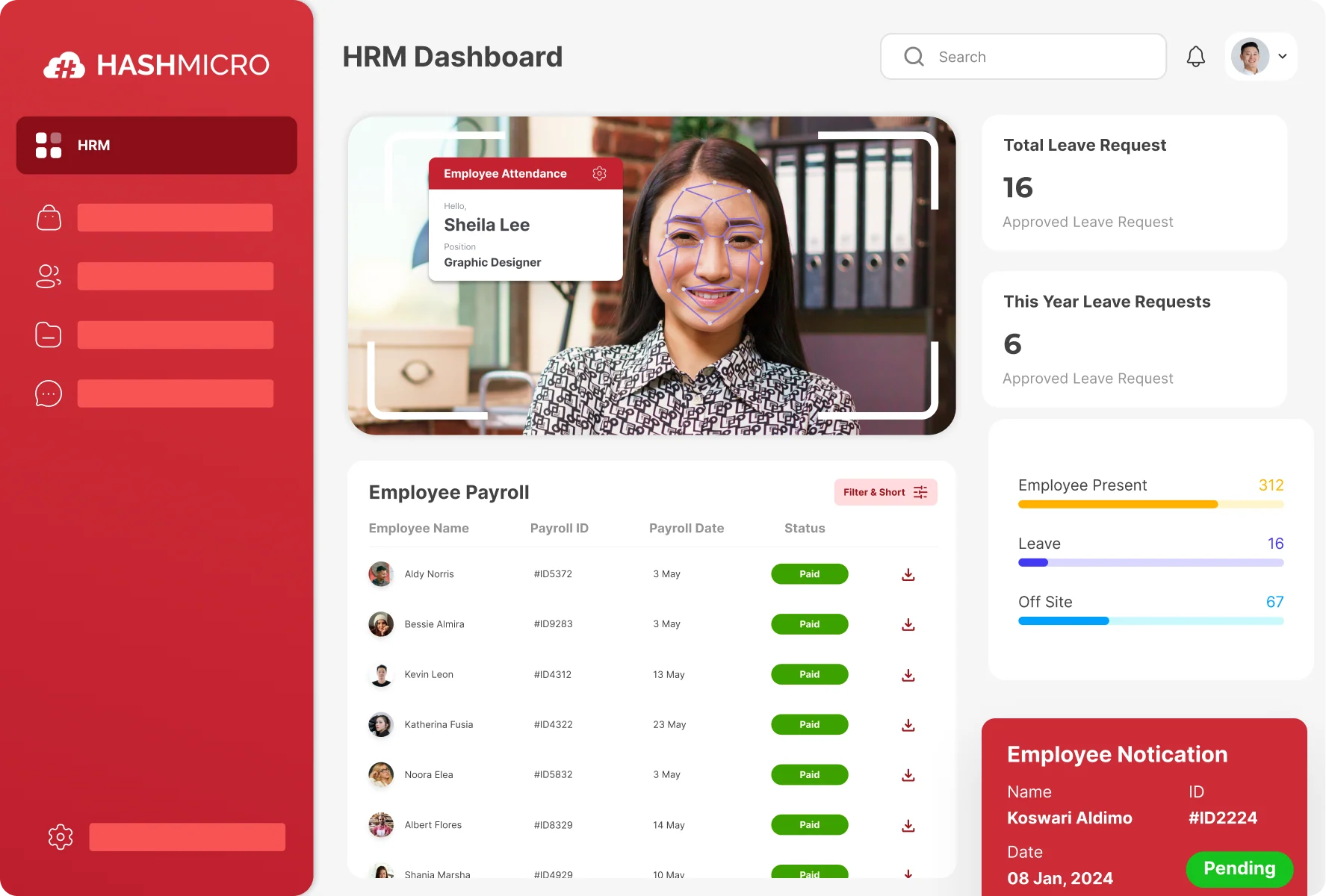Payroll processing sounds like a simple matter, but why does it seem like there’s so much to take care of? From tracking work hours to calculating deductions, it can quickly become overwhelming.
But even though it can be tiring, payroll is one of the most important tasks sa kahit anong business One small mistake can lead to delayed payments, compliance issues, or unhappy employees. And we don’t want that to happen, do we?
However, there’s good news: we’ve got you covered. In this guide, you’ll learn everything about payroll processing, plus tips to make it faster, easier, and hassle-free for your business. Read on to find out more about payroll management in the Philippines!
Key Takeaways
|
Table of Content
Content Lists
What is Payroll Processing?
Payroll processing is an essential, recurring task for every business. This process is typically divided into three main stages: pre-payroll, payroll processing, and post-payroll. Each stage includes several sub-steps and tasks that contribute to accurate and efficient payroll management.
Typically done at the end of a pay period, payroll processing ensures accurate calculation, tracking, and distribution of salaries. It also verifies proper withholding for taxes, company benefits, and other deductions.
Payroll is usually managed by dedicated payroll professionals or handled within the human resources department. Businesses may rely on in-house staff, third-party providers, or outsourced teams for this process.
While payroll can be processed manually, most businesses prefer using payroll software for efficiency. On the other hand, many companies also prefer payroll outsourcing instead, in which they hand over the task of everything payroll-related to a third party.
How Does Payroll Processing Work?
While payroll in the Philippines isn’t overly complex, it involves multiple tasks that must be completed accurately. The process is divided into three stages: pre-payroll, actual payroll, and post-payroll. Here’s what happens at each stage to ensure employees are paid correctly and on time.
1. Pre-Payroll Activities
Pre-payroll tasks are the preparations needed before processing payments. They involve key administrative decisions, legal registrations, and data collection to set the stage for accurate payroll runs.
- Employer Registration: Register with local tax authorities and social security bodies to get identification numbers and onboard new hires.
- Payroll Policy Development: Create policies covering pay periods (weekly, monthly), payment methods (direct deposit, check), and other payroll guidelines.
- Payroll System Setup: Implement either in-house payroll software or partner with an outsourced payroll service provider.
- Data Collection: Gather employee information, tax documents, compensation details, work hours, PTO records, and other relevant data.
- Data Validation: Verify the accuracy of collected data to prevent errors in payroll calculations.
2. Actual Payroll Processing
After pre-payroll tasks are done, businesses calculate employee pay. The time required for this depends on whether payroll is managed manually or through software.
- Gross Pay Calculation: Factor in hours worked, PTO, overtime, and other earnings.
- Deductions and Taxes: Compute payroll taxes, insurance premiums, garnishments, and other deductions.
- Net Pay Determination: Subtract deductions from gross pay to calculate take-home pay.
- Accuracy Check: Review payroll calculations to ensure accuracy.
- Payment Distribution: Issue employee payments via the selected method, such as direct deposit or checks.
3. Post-Payroll Activities
Issuing payments isn’t the final step in payroll processing. Several follow-up activities are required to maintain compliance and proper record-keeping.
- Payslip Distribution: Provide employees with payslips, either electronically or in print. A well-structured payslip template can simplify this task, ensuring that every payslip contains the essential details.
- Tax Reporting: Submit payroll tax withholdings (income tax, social security contributions) to the appropriate government agencies.
- Compliance Reporting: File necessary reports, such as gender pay gap disclosures, that require payroll data.
- Record-Keeping: Maintain payroll records and handle accounting tasks related to payroll for auditing and compliance purposes.
Basic Steps to Payroll Processing
 Here are the basic steps for manually processing payroll in the Philippines. You can use these as a guide for your payroll process or as a quick refresher if you have prior payroll experience.
Here are the basic steps for manually processing payroll in the Philippines. You can use these as a guide for your payroll process or as a quick refresher if you have prior payroll experience.
Steps to Take Before Calculating Pay:
- Register your business with the Bureau of Internal Revenue (BIR) to get a Tax Identification Number (TIN) and secure employer registration with SSS, PhilHealth, and Pag-IBIG.
- Collect employee tax and financial information, including their TIN, SSS, PhilHealth, and Pag-IBIG numbers, plus a copy of their BIR Form 1902 for new hires.
- Set up a payroll schedule, commonly bi-weekly or semi-monthly, as required under Philippine labor laws.
- Choose the payroll schedule that fits your business needs while ensuring compliance with the Labor Code of the Philippines.
- Establish deadlines for remitting government contributions and withholding taxes to the BIR, SSS, PhilHealth, and Pag-IBIG.
Steps to Manually Process Payroll:
- Calculate Gross Pay based on basic salary, hours worked, overtime, holiday pay, night shift differential, and other earnings like 13th-month pay.
- Determine Deductions for withholding tax (following BIR tax tables), SSS, PhilHealth, Pag-IBIG, and other authorized deductions (e.g., loans).
- Calculate Net Pay by subtracting total deductions from the gross pay.
- Issue Payments via the employee’s preferred method, such as direct deposit, cash, or check.
- Maintain Payroll Records for tax and audit purposes, as required by the BIR and DOLE.
Review each step carefully to avoid errors in calculations and deductions. Also, remember to report new hires to the BIR and register them with SSS, PhilHealth, and Pag-IBIG to comply with government regulations.
How to Process Payroll
Processing payroll may seem complex, but breaking it down into steps makes it manageable.
Here’s how to handle payroll efficiently, starting with the basics every business needs to cover.
Step 1: Register Your Business with Government Agencies
The first step in processing payroll is registering your business with the Bureau of Internal Revenue (BIR) to obtain a Tax Identification Number (TIN). You must also register with the Social Security System (SSS), PhilHealth, and the Home Development Mutual Fund (Pag-IBIG).
These registrations are required whether you process payroll manually or through payroll system. The government uses these IDs to track tax contributions and ensure compliance with employment laws.
If you don’t have a TIN, you can apply at the nearest BIR office. For SSS, PhilHealth, and Pag-IBIG numbers, complete the necessary employer registration forms with each agency.
Step 2: Gather Employee Tax and Employment Information
Before processing payroll, collect necessary employee documents to ensure accurate tax deductions and contributions. In the Philippines, employees must submit:
- BIR Form 1902 (for new hires) to register their TIN with their new employer.
- SSS, PhilHealth, and Pag-IBIG numbers for contribution tracking.
- A copy of their government-issued ID for verification.
You should also have these documents on file:
- Job Application or Employment Contract: Ensures all employee details are documented for payroll records.
- Deductions Authorization: Covers voluntary deductions like health insurance, loans, or savings contributions.
- Court-Ordered Deductions: If applicable, documents related to wage garnishments (e.g., legal obligations like child support) must be kept for compliance.
Step 3: Set Up a Payroll Schedule
After registering your business and gathering employee information, choose a payroll schedule. In the Philippines, common payroll schedules include:
- Monthly (once a month)
- Semi-Monthly (twice a month, often on the 15th and 30th)
- Bi-Weekly (every two weeks)
- Weekly (common in industries like construction or retail)
Once you’ve selected a schedule, create a payroll calendar to track pay dates, deadlines for processing payroll, tax filing schedules (such as BIR Form 1601-C for withholding tax), and government remittance dates for SSS, PhilHealth, and Pag-IBIG.
Step 4: Calculate Gross Pay
After setting your payroll schedule, the next step is to calculate each employee’s gross pay, which is the total earnings before deductions.
For monthly-paid employees, divide their annual salary by 12 to get their monthly gross pay. For daily or hourly workers, multiply the number of hours worked in a pay period by their hourly rate.
When calculating hours worked, include overtime, holiday pay, and night shift differentials, as required by the Labor Code of the Philippines. Overtime is typically paid at 125% of the regular rate, while work on regular holidays is paid at 200% of the daily wage.
Example:
- Employee A earns ₱500/day and works 22 days in a month.
- Regular Pay: ₱500 × 22 = ₱11,000
- Overtime (10 hours at ₱62.50/hour): ₱625
- Gross Pay: ₱11,000 + ₱625 = ₱11,625
For salaried employees earning ₱600,000 annually with a monthly schedule:
₱600,000 ÷ 12 = ₱50,000 gross monthly pay.
Step 5: Determine Employee Deductions
After calculating gross pay, you need to determine mandatory and voluntary deductions. In the Philippines, deductions include:
- Withholding Tax: Based on the BIR’s latest tax tables.
- SSS Contributions: Both employee and employer shares, calculated using SSS contribution schedules.
- PhilHealth Contributions: Based on the employee’s salary bracket.
- Pag-IBIG Contributions: Typically 1-2% of the monthly compensation.
- Other Deductions: Loan repayments, insurance, or other voluntary contributions authorized by the employee.
Step 6: Calculate Net Pay and Pay Your Employees
After determining the deductions, subtract them from the employee’s gross pay to get the net pay or take-home pay. This is the amount you’ll give to your employees. The withheld deductions (like taxes and contributions) must be remitted to government agencies based on their monthly or quarterly deadlines.
Once the net pay is finalized, you can distribute salaries on the scheduled payday. Common payment methods in the Philippines include:
- Direct deposit to the employee’s bank account (the most common and secure method)
- Payroll ATM cards provided by partner banks
- Mobile wallets like GCash or PayMaya
- Cash payments, often used in small businesses, though this requires detailed record-keeping for compliance and security.
Step 7: Maintain Payroll Records and Make Corrections
Keeping accurate payroll records is vital for tax compliance and resolving any payment disputes. In the Philippines, employers must retain payroll records for at least 10 years as required by the BIR.
These records should include payslips, proof of tax withholdings, government remittance receipts, and year-to-date summaries.
If an employee raises concerns about their salary, having organized records helps resolve issues quickly. This also protects your business during audits by government agencies like the DOLE or BIR.
Step 8: Monitor Ongoing Payroll Responsibilities
Payroll isn’t a one-time task—you’ll need to file monthly and quarterly tax returns, such as:
- BIR Form 1601-C (monthly withholding tax return)
- SSS, PhilHealth, and Pag-IBIG monthly contribution reports
- BIR Form 2316 (annual tax summary for employees)
Additionally, you must report new hires to the BIR, SSS, PhilHealth, and Pag-IBIG upon onboarding. If you’re using payroll software or outsourcing payroll, these reports are often handled automatically.
Signs to Reevaluate Your Payroll Processing Practices
 Managing payroll comes with its fair share of challenges. You might forget to process payroll, spend too much time on manual calculations, or struggle to keep up consistently.
Managing payroll comes with its fair share of challenges. You might forget to process payroll, spend too much time on manual calculations, or struggle to keep up consistently.
Sometimes, the signs that your payroll process needs improvement are easy to miss, especially if you’re too busy to notice. If you experience any of these issues below, it could be a sign that it’s time to reassess your payroll procedures.
1. Your Business is Expanding
Growth is a positive sign for any business, but it may also mean it’s time to reassess your payroll process. As you hire more employees, managing payroll manually becomes increasingly challenging due to the additional calculations required.
If you’re still processing payroll by hand, consider switching to the best payroll software or outsourcing the task. Even if you already use software, ensure it can support your growing workforce, as some systems have limits (e.g., up to 50 employees).
One of the software you can use, which can grow with your company size while maintaining its optimal performance is HashMicro.
What’s more exciting, you need to only pay flat pricing at the start, and it offers unlimited users, so no matter how many employees join your company, it can accommodate all. Click on the banner below to find your customized quote!

2. You’re Struggling to Keep Up
If payroll tasks are eating up too much of your time, it might be time to rethink your approach. Payroll processing doesn’t have to be overwhelming or time-consuming.
Consider outsourcing to a Professional Employer Organization (PEO) to handle payroll duties, though this can be costly.
3. Payroll Costs Are Too High
If payroll is becoming a financial burden, it may be time to explore more cost-effective solutions. There are affordable and reliable payroll options available, so don’t hesitate to shop around.
Research different payroll software providers, comparing costs, features, and user reviews. If you have a small team, handling payroll manually could help cut costs, though it may require more time.
4. You Need a Faster Payment Method
Are your employees requesting direct deposit or looking for a more convenient way to receive their salaries? If yes, it might be time to reconsider your payroll’s payment method.
In the Philippines, employers can choose from several options to pay their staff, including:
- Cash payments (common in small businesses)
- Handwritten or printed checks
- Mobile wallets like GCash or PayMaya
- Direct bank deposits
- Payroll ATM cards provided by partner banks
If you want a faster payment process, review your current methods. Check with your bank to see if they offer bulk payroll services for direct deposits or pay cards.
Payroll software can also provide multiple payment options. If you’re already using software, explore its features to maximize convenience for both you and your employees.
5. You’re Struggling to Obey the Regulations
A critical part of payroll processing is handling government contributions and tax compliance. To stay compliant in the Philippines, you must accurately calculate, withhold, and remit payments for SSS, PhilHealth, Pag-IBIG, and BIR withholding taxes.
If you’re missing deadlines, miscalculating contributions, or forgetting to file reports like BIR Form 1601-C or SSS R3, it’s a clear sign you need to improve your payroll process.
To ensure compliance, you can:
- Invest in full-service payroll software that automates calculations, tax filings, and government remittances.
- Hire an accountant or CPA to handle payroll taxes to fill out forms and reports accurately.
Full-service payroll handles calculations, tax filings, and payments for you, ensuring deadlines are met. An accountant or CPA can also manage these tasks, but it may cost more. Either way, both options help keep your business
Tips to Optimize Payroll Processing
Tired of payroll headaches? Whether it’s delays, errors, or compliance issues, a few smart tweaks can save you time and stress. Want a smoother, more efficient payroll process? Here’s how to make it faster, easier, and fully compliant:
- Develop a clear payroll policy to guide processes and set expectations.
- Adjust your payroll cycle and frequency to match your business operations.
- Leverage time-tracking and payroll software for accuracy and efficiency.
- Offer flexible payment methods like direct deposits or mobile wallets for faster salary disbursement.
- Hire skilled payroll professionals who understand both the technical and legal side of payroll.
- Stay updated on payroll laws and regulations to avoid compliance issues.
A few changes can make a big difference: less hassle, more accuracy, and a lot of time saved.
Manage Payroll Processing Effectively with HashMicro
 Handling payroll isn’t just about crunching numbers. Rather, it’s about making sure your team gets paid accurately and on time. But as your business grows, juggling calculations, deductions, and compliance can get overwhelming fast.
Handling payroll isn’t just about crunching numbers. Rather, it’s about making sure your team gets paid accurately and on time. But as your business grows, juggling calculations, deductions, and compliance can get overwhelming fast.
That’s where HashMicro Payroll System comes in. It takes the hassle out of payroll, automating everything from calculations to payment processing, so you can focus on what really matters, which is managing your employees’ matters effectively.
The best part? HashMicro handles unlimited users, processes payroll like a pro, and is trusted by over 2,000 companies across Southeast Asia. It’s payroll done right, with zero fuss and maximum efficiency.
HashMicro offers these features to help you:
- Automated Payroll Processing – Covers salary calculations, tax deductions, and seamless bank transfers with major banks.
- Regulatory Compliance – Ensures adherence to the Philippines’ Labor Laws for contracts, attendance, leave, overtime, and payroll.
- Employee Self-Service & Mobile App – Employees can manage attendance, leave, overtime, and payslips through a mobile app, reducing HR workload.
- Comprehensive Leave Management – Includes leave encashment, unpaid leave, carryover options, and expiration dates for flexible policies.
- Overtime & Late Deduction Automation – Accurate calculations for overtime, meal allowances, and late deductions processed directly in payroll.
Conclusion
Payroll processing covers everything from registration and data collection to salary calculations and compliance reporting. It ensures na employees get paid accurately and on time while meeting government requirements like taxes and contributions.
If handling payroll feels overwhelming, HashMicro Payroll System is here to make things easier for you. It automates salary calculations, deductions, and payments, so you can focus on growing your business. No more manual errors or missed deadlines; just smooth payroll management every payday.
What’s even better? HashMicro supports unlimited users, processes payroll like a pro, and is trusted by over 2,000 companies in Southeast Asia. With its advanced features, it handles compliance, employee data, and even mobile access effortlessly.
Say goodbye to complicated payroll processing by trying the free demo now!

Frequently Asked Questions on Payroll Process
-
What are the benefits of outsourcing payroll process services in the Philippines?
Outsourcing payroll means letting experts handle salary calculations, tax deductions, and government contributions for you. This helps businesses avoid mistakes, save time, and stay compliant with labor laws. It also allows business owners to focus on growing their company instead of dealing with payroll paperwork.
-
How do payroll software solutions address the unique needs of Philippine businesses?
Payroll software in the Philippines can handle local tax rules, SSS, PhilHealth, and Pag-IBIG deductions automatically. It ensures the employers pay the salary on time while also generating reports needed for government compliance. This makes payroll faster, more accurate, and hassle-free for businesses.
-
What is supplemental pay?
Supplemental pay refers to compensation for employees in amounts that differ from an employee’s regular hourly, daily, or similar periodic rate. Examples include bonuses, commissions, overtime pay, and severance pay. This type of compensation may be taxed differently than an employee’s base wage and salary.
{
“@context”: “https://schema.org”,
“@type”: “FAQPage”,
“mainEntity”: [{
“@type”: “Question”,
“name”: “What are the benefits of outsourcing payroll process services in the Philippines?”,
“acceptedAnswer”: {
“@type”: “Answer”,
“text”: “Outsourcing payroll means letting experts handle salary calculations, tax deductions, and government contributions for you. This helps businesses avoid mistakes, save time, and stay compliant with labor laws. It also allows business owners to focus on growing their company instead of dealing with payroll paperwork.”
}
},{
“@type”: “Question”,
“name”: “How do payroll software solutions address the unique needs of Philippine businesses?”,
“acceptedAnswer”: {
“@type”: “Answer”,
“text”: “Payroll software in the Philippines can handle local tax rules, SSS, PhilHealth, and Pag-IBIG deductions automatically. It ensures the employers pay the salary on time while also generating reports needed for government compliance. This makes payroll faster, more accurate, and hassle-free for businesses.”
}
},{
“@type”: “Question”,
“name”: “What is supplemental pay?”,
“acceptedAnswer”: {
“@type”: “Answer”,
“text”: “Supplemental pay refers to compensation for employees in amounts that differ from an employee’s regular hourly, daily, or similar periodic rate. Examples include bonuses, commissions, overtime pay, and severance pay. This type of compensation may be taxed differently than an employee’s base wage and salary.”
}
}]
}




































